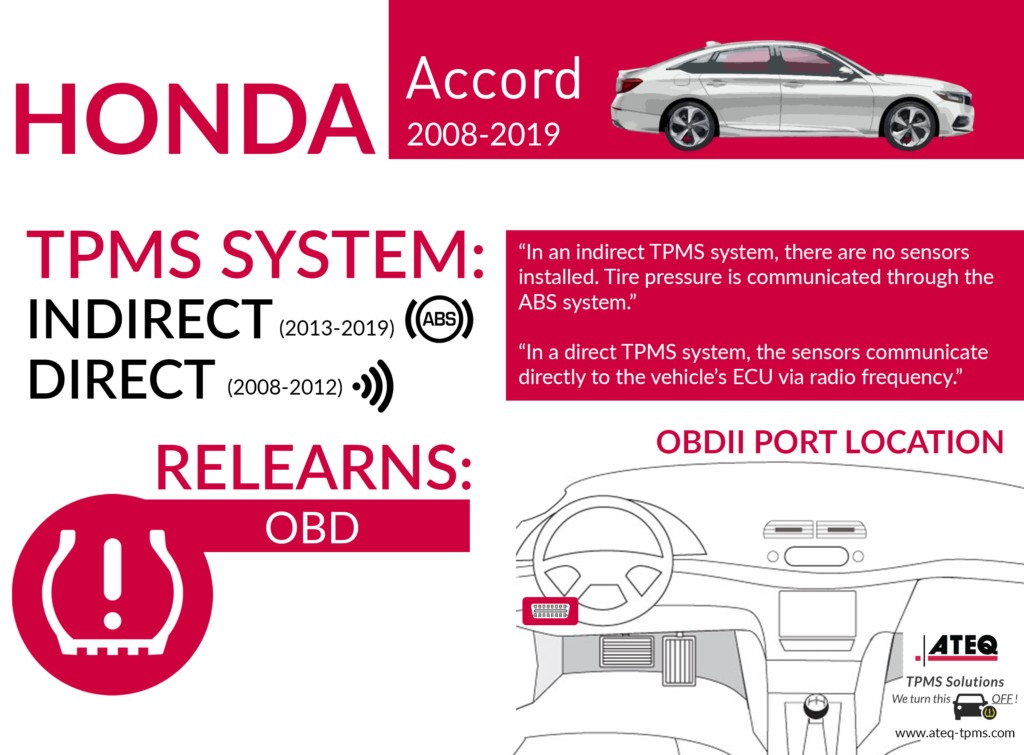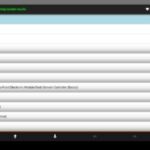For Honda Accord owners, especially those with the 2008 model, understanding your vehicle’s Tire Pressure Monitoring System (TPMS) is crucial for safety and maintenance. Since 2008, US-manufactured vehicles, including the Honda Accord, have been mandated to include TPMS, but the type and procedures can vary. This guide focuses on using an OBD scanner for your 2008 Honda Accord TPMS needs, offering a comprehensive look at the system, maintenance, and how to use an OBD scanner effectively.
Understanding the TPMS in Your 2008 Honda Accord
The 2008 Honda Accord utilizes a direct TPMS system. This means it has physical TPMS sensors inside each wheel. These sensors directly measure tire pressure and transmit this data to your car’s ECU (Engine Control Unit). If your tire pressure drops below a certain threshold, these sensors alert you via a warning light on your dashboard. Some systems may even display the individual pressure of each tire, providing precise information.
Knowing that your 2008 Accord uses a direct TPMS is the first step. This system requires specific maintenance procedures, especially when replacing tires or TPMS sensors. This is where an OBD scanner becomes invaluable.
Why Use an OBD Scanner for Your 2008 Honda Accord TPMS?
An OBD (On-Board Diagnostics) scanner is a tool that connects to your vehicle’s computer system. For a 2008 Honda Accord with direct TPMS, an OBD scanner is essential for several maintenance tasks:
- TPMS Sensor Replacement: When you replace a TPMS sensor (due to damage, battery failure, or when installing new tires), the new sensor’s ID needs to be registered with your vehicle’s ECU. An OBD scanner is often required to perform this “TPMS relearn” procedure. Without it, the TPMS warning light may remain on, even with new sensors.
- TPMS Relearn Procedure: Even without replacing sensors, a TPMS relearn might be necessary. This can be triggered by tire rotation or if the TPMS system isn’t recognizing the sensors properly. For the 2008 Honda Accord, an OBD relearn via the OBD port is the standard procedure, requiring a compatible OBD scanner.
- Reading TPMS DTC Codes: If your TPMS warning light is on, an OBD scanner can read Diagnostic Trouble Codes (DTCs) related to the TPMS system. These codes pinpoint the issue, whether it’s a faulty sensor, communication problem, or other malfunction. This diagnostic capability saves time and guesswork in repairs.
- Regular Maintenance and Checks: While not needed for every tire inflation, using an OBD scanner periodically to check for TPMS codes can help proactively identify potential issues before they become critical.
In essence, for a 2008 Honda Accord with direct TPMS, an OBD scanner is not just a useful tool, but often a necessary one for proper TPMS maintenance and ensuring the system functions correctly.
OBD Relearn Procedure for 2008-2012 Honda Accord (Direct TPMS)
The OBD relearn procedure for the 2008-2012 Honda Accord models, which all use direct TPMS, requires an OBDII dongle and a compatible TPMS scan tool. Here’s a step-by-step guide:
-
Ensure proper sensor installation: Verify that the new TPMS sensors are correctly installed in the wheels and tires are properly mounted.
-
Inflate tires to placard pressure: Adjust all tire pressures to the recommended values found on your vehicle’s tire placard (usually on the driver’s side doorjamb).
-
Activate sensors with TPMS tool: Using your TPMS activation tool, start with the left front tire, holding the tool against the tire sidewall near the valve stem. Activate the sensors in a counter-clockwise order: Left Front, Left Rear, Right Rear, and Right Front. This specific order is crucial for Honda Accord OBD relearns.
-
Connect OBD module: Plug the OBD module of your TPMS tool into the DLC (Diagnostic Link Connector) port in your Honda Accord (usually located under the dashboard on the driver’s side).
-
Turn ignition ON: Turn the ignition to the “ON” position, but do not start the engine.
-
Transfer sensor data: On your TPMS tool, press “OK” or the designated button to initiate the transfer of sensor data to the vehicle’s ECU via the OBD module.
-
Disconnect OBD module: Once the data transfer is complete (as indicated by your TPMS tool), disconnect the OBD module from the DLC.
-
Turn ignition OFF and restart: Turn the ignition OFF, and then start the engine. The TPMS warning light should turn off after driving a short distance, indicating successful relearn.
Important Note: Honda’s direct TPMS OBD relearn is unique in its sensor activation order. Always follow the Left Front, Left Rear, Right Rear, Right Front sequence for a successful relearn procedure.
Troubleshooting TPMS Issues on Your 2008 Honda Accord
Even with proper maintenance, TPMS issues can arise. Here are some troubleshooting tips, particularly relevant to using an OBD scanner:
- Use an OBD Scanner for DTC Codes: If the TPMS light remains on after a relearn or illuminates unexpectedly, use your OBD scanner to retrieve TPMS DTC codes. These codes will guide you to the source of the problem, whether it’s a specific sensor, receiver, or wiring issue.
- “MIL Flash” After Relearn: As per the Tire Industry Association (TIA), after registering new sensor IDs on 2008-2012 Honda Accords, the TPMS Malfunction Indicator Light (MIL) may flash. This is normal and should stop after driving for 1-10 miles as the vehicle learns the new sensor IDs.
- Check Sensor Batteries: Direct TPMS sensors have batteries that typically last for 5-7 years. If sensors are original to a 2008 vehicle, battery failure is a likely cause of TPMS issues. DTC codes from an OBD scanner can often indicate low sensor battery voltage.
- Inspect Sensors for Damage: Physical damage to sensors during tire changes or due to road debris can also cause malfunctions. Visually inspect sensors (if accessible) and check for DTCs that might indicate sensor faults.
By using an OBD scanner in conjunction with these troubleshooting tips, you can effectively diagnose and address TPMS problems on your 2008 Honda Accord.
Choosing the Right OBD Scanner for Your 2008 Honda Accord TPMS
When selecting an OBD scanner for your 2008 Honda Accord TPMS maintenance, consider these features:
- TPMS Relearn Capability: Ensure the scanner supports OBD relearn procedures for direct TPMS systems, specifically for Honda vehicles.
- DTC Reading and Clearing: The scanner should be able to read and clear TPMS Diagnostic Trouble Codes.
- Live Data Stream: Some advanced scanners offer live TPMS data, allowing you to see real-time tire pressures and sensor status.
- User-Friendliness: Choose a scanner with an intuitive interface and clear instructions, especially if you are a DIY user.
- Compatibility: While most OBDII scanners are universally compatible, double-check that the scanner specifically lists compatibility with 2008 Honda Accord models and TPMS functions.
Investing in a quality OBD scanner will empower you to maintain your 2008 Honda Accord’s TPMS effectively, ensuring safety and prolonging tire life.
Conclusion
Understanding the direct TPMS system in your 2008 Honda Accord and utilizing an OBD scanner are key to proper maintenance and troubleshooting. From performing TPMS relearns after sensor replacements to diagnosing warning lights with DTC codes, an OBD scanner is an indispensable tool for any 2008 Honda Accord owner. By following the correct procedures and using the right equipment, you can keep your TPMS system functioning optimally, contributing to safer driving and vehicle longevity.


